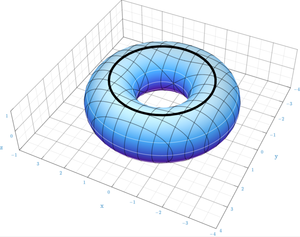From Wikipedia, the free encyclopedia
"Round function" may also refer to rounding . In topology and in calculus , a round function is a scalar function
M
→
R
{\displaystyle M\to {\mathbb {R} }}
manifold
M
{\displaystyle M}
critical points form one or several connected components , each homeomorphic to the circle
S
1
{\displaystyle S^{1}}
Morse-Bott functions .
The black circle in one of this critical loops.
For instance
For example, let
M
{\displaystyle M}
torus . Let
K
=
(
0
,
2
π
)
×
(
0
,
2
π
)
.
{\displaystyle K=(0,2\pi )\times (0,2\pi ).\,}
Then we know that a map
X
:
K
→
R
3
{\displaystyle X\colon K\to {\mathbb {R} }^{3}\,}
given by
X
(
θ
,
ϕ
)
=
(
(
2
+
cos
θ
)
cos
ϕ
,
(
2
+
cos
θ
)
sin
ϕ
,
sin
θ
)
{\displaystyle X(\theta ,\phi )=((2+\cos \theta )\cos \phi ,(2+\cos \theta )\sin \phi ,\sin \theta )\,}
is a parametrization for almost all of
M
{\displaystyle M}
π
3
:
R
3
→
R
{\displaystyle \pi _{3}\colon {\mathbb {R} }^{3}\to {\mathbb {R} }}
G
=
π
3
|
M
:
M
→
R
,
(
θ
,
ϕ
)
↦
sin
θ
{\displaystyle G=\pi _{3}|_{M}\colon M\to {\mathbb {R} },(\theta ,\phi )\mapsto \sin \theta \,}
G
=
G
(
θ
,
ϕ
)
=
sin
θ
{\displaystyle G=G(\theta ,\phi )=\sin \theta }
g
r
a
d
G
(
θ
,
ϕ
)
=
(
∂
G
∂
θ
,
∂
G
∂
ϕ
)
(
θ
,
ϕ
)
=
(
0
,
0
)
,
{\displaystyle {\rm {grad}}\ G(\theta ,\phi )=\left({{\partial }G \over {\partial }\theta },{{\partial }G \over {\partial }\phi }\right)\!\left(\theta ,\phi \right)=(0,0),\,}
this is if and only if
θ
=
π
2
,
3
π
2
{\displaystyle \theta ={\pi \over 2},\ {3\pi \over 2}}
These two values for
θ
{\displaystyle \theta }
X
(
π
/
2
,
ϕ
)
=
(
2
cos
ϕ
,
2
sin
ϕ
,
1
)
{\displaystyle X({\pi /2},\phi )=(2\cos \phi ,2\sin \phi ,1)\,}
X
(
3
π
/
2
,
ϕ
)
=
(
2
cos
ϕ
,
2
sin
ϕ
,
−
1
)
{\displaystyle X({3\pi /2},\phi )=(2\cos \phi ,2\sin \phi ,-1)\,}
which represent two extremal circles over the torus
M
{\displaystyle M}
Observe that the Hessian for this function is
h
e
s
s
(
G
)
=
[
−
sin
θ
0
0
0
]
{\displaystyle {\rm {hess}}(G)={\begin{bmatrix}-\sin \theta &0\\0&0\end{bmatrix}}}
which clearly it reveals itself as rank of
h
e
s
s
(
G
)
{\displaystyle {\rm {hess}}(G)}
Round complexity
Mimicking the L–S category theory one can define the round complexity asking for whether or not exist round functions on manifolds and/or for the minimum number of critical loops.
References
Siersma and Khimshiasvili, On minimal round functions , Preprint 1118, Department of Mathematics, Utrecht University, 1999, pp. 18.[1] . An update at [2] 
















